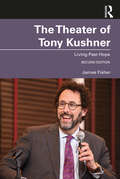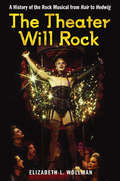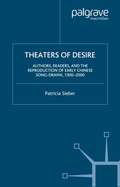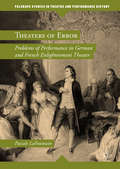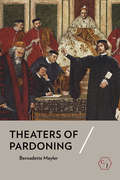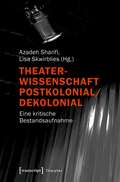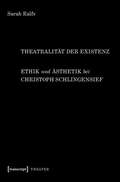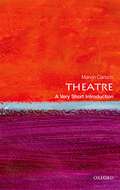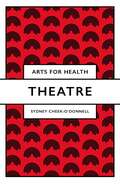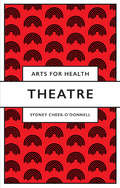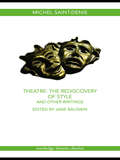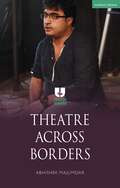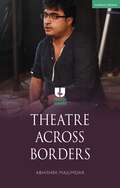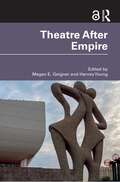- Table View
- List View
The Theater of Tony Kushner: Living Past Hope
by James FisherThe Theater of Tony Kushner is a comprehensive portrait of the forty-year long career of dramatist Tony Kushner as playwright, screenwriter, essayist, and public intellectual and political activist. Following an introduction examining the influences of Kushner’s development as an artist, this updated second edition features individual chapters on his major plays, including A Bright Room Called Day, Hydriotaphia, or The Death of Dr. Browne, Angels in America, Slavs! Thinking About the Longstanding Problems of Virtue and Happiness, Homebody/Kabul, Caroline, or Change, and The Intelligent Homosexual’s Guide to Capitalism and Socialism with a Key to the Scriptures, along with chapters on Kushner’s adaptations, one-act plays, and screenplays, including his two Academy Award-nominated screenplays, Munich and Lincoln. A book for anyone interested in theater, film, literature, and the ways in which the past informs the present, this second edition of The Theater of Tony Kushner explores how his writings reflect key elements of American society, from politics and economics to race, gender, and spirituality, all with the hope of inspiring America to live up to its ideals.
Theater Planning: Facilities for Performing Arts and Live Entertainment
by Gene LeitermannThis book introduces the concepts of theater planning, and provides a detailed guide to the process and the technical requirements particular to theater buildings. Part I is a guide to the concepts and practices of architecture and construction, as applied to performing arts buildings. Part II is a guide to the design of performing arts buildings, with detailed descriptions of the unique requirements of these buildings. Each concept is illustrated with line drawings and examples from the author’s extensive professional practice. This book is written for students in Theatre Planning courses, along with working practitioners.
Theater Planning: Facilities for Performing Arts and Live Entertainment
by Gene LeitermannThis book introduces the concepts of theater planning, and provides a detailed guide to the process and the technical requirements particular to theater buildings. Part I is a guide to the concepts and practices of architecture and construction, as applied to performing arts buildings. Part II is a guide to the design of performing arts buildings, with detailed descriptions of the unique requirements of these buildings. Each concept is illustrated with line drawings and examples from the author’s extensive professional practice. This book is written for students in Theatre Planning courses, along with working practitioners.
Theater, Terror, Tod: Das Künstlerdrama von Christoph Schlingensief (Theater #166)
by Giovanna-Beatrice CarlessoChristoph Schlingensiefs autoreferenzielles Theater verhandelt Kunst- und Künstlerdiskurse im Kontext avantgardistischer Theorie und Praxis. In detaillierten Text- und Aufführungsanalysen nimmt Giovanna-Beatrice Carlesso zwei der komplexesten und anspielungsreichsten Inszenierungen des Autor-Regisseurs in den Blick, um ein dichtes Netz aus intermedialen Selbst- und Fremdzitaten im Nexus von Kunst, Terror und Tod zu entwirren. Dabei beleuchtet sie erstmals die longue durée des Künstlerdramas und erforscht dessen Weiterentwicklung durch Schlingensief in Zeiten der Postdramatik.
The Theater Will Rock: A History of the Rock Musical, from Hair to Hedwig (Anthropology series)
by Elizabeth Lara WollmanThe tumultuous decade of the 1960s in America gave birth to many new ideas and forms of expression, among them the rock musical. An unlikely offspring of the performing arts, the rock musical appeared when two highly distinctive and American art forms joined onstage in New York City. The Theater Will Rock explores the history of the rock musical, which has since evolved to become one of the most important cultural influences on American musical theater and a major cultural export. Packed with candid commentary by members of New York's vibrant theater community, The Theater Will Rock traces the rock musical's evolution over nearly fifty years, in popular productions such as Hair, The Who's Tommy, Jesus Christ Superstar, The Rocky Horror Picture Show, Little Shop of Horrors, Rent, and Mamma Mia!---and in notable flops such as The Capeman. "A much-needed study of the impact of rock music on the musical theater and its resulting challenges, complexities, failures, and successes. Anyone interested in Broadway will learn a great deal from this book." ---William Everett, author of The Musical: A Research Guide to Musical Theatre "This well-written account puts the highs and lows of producing staged rock musicals in New York City into perspective and is well worth reading for the depth of insight it provides." ---Studies in Musical Theatre Elizabeth L. Wollman is Assistant Professor of Music at Baruch College, City University of New York.
Theatermaschinen - Maschinentheater: Von Mechaniken, Machinationen und Spektakeln (Theater #135)
by Bettine Menke Wolfgang StruckTheater sind Maschinen des Erscheinens. Und Theatermaschinen, die erscheinen lassen, verbergen sich selbst und bezeugen sich in ihren Effekten. Das teilen sie mit den Machinationen, wie Intrigen bis ins 19. Jahrhundert hießen. Sie widerstreiten dem Primat der dramatischen Handlung und ermöglichen in Verbindung mit Musik und anderen Illuminationen Theater als Spektakel. Die Beiträger*innen des Bandes fragen nach dem Zusammenhang von Maschine, Machination, Schauspiel und Schauraum. Mit der Figur der Maschine denken sie das Theater von seinen Rändern her und arbeiten heraus, wie ein maschineninduziertes Spektakel auch in Theaterformen (weiter-)lebt, denen das Spektakuläre suspekt geworden ist.
Theaterproben und Interaktion: Sprech- und theaterwissenschaftliche Perspektiven (Theater #159)
by Anna WesselWie werden künstlerische Ideen von Regie und Schauspieler*innen in Theaterproben interaktiv entwickelt, vermittelt und ausgehandelt? Anna Wessel betrachtet Probeninteraktionen aus sprechwissenschaftlicher Perspektive und kombiniert diese mit theaterwissenschaftlichen und linguistischen Aspekten. Dabei stellt sie die Besprechungsphasen von Theaterproben in den Fokus und zeigt auf, welche interaktiven Probenpraktiken zum Einsatz kommen, wie mit ihnen Instruktionen der Regie gestaltet werden und wie die Schauspieler*innen darauf sprachlich und spielend reagieren. Die Erkenntnisse liefern eine neue Perspektive auf interaktive Prozesse theatraler Probenarbeit - in Theorie und Praxis.
Theaters of Desire: Authors, Readers, and the Reproduction of Early Chinese Song-Drama, 1300–2000
by P. SieberBlending a flair for textual nuance with theoretical engagement, Theaters of Desire not only contributes to our understanding of the most influential form of early Chinese song-drama in local and international cultural contexts, but adds a Chinese perspective to the scholarship on print culture, authorship, and the regulatory discourses of desire. The book argues that, particularly between 1550 and 1680, Chinese elite editors rewrote and printed early plays and songs, so-called Yuan-dynasty zaju and sanqu , to imagine and embody new concepts of authorship, readership and desire, an interpretation that contrasts starkly with the national and racially-oriented reception of song-drama developed by European critics after 1735 and subsequently modified by Japanese and Chinese critics after 1897. By analyzing the critical and material facets of the early song and play tradition across different historical periods and cultural settings, Theaters of Desire presents a compelling case study of literary canon formation.
Theaters of Error: Problems of Performance in German and French Enlightenment Theater (Palgrave Studies in Theatre and Performance History)
by Pascale LaFountainThis book offers provocative readings of canonical Enlightenment dramas that reflect and shape the period’s changing understanding of error. With striking interdisciplinary connections to theater treatises as well as works from the philosophical, legal, and medical discourses, it tracks the relocation of error from the moral to the physical realm, a movement that begins with Lessing and continues through the turn of the nineteenth century.Featuring detailed analyses of Lessing’s Miß Sara Sampson, Diderot’s Le Fils naturel, Schiller’s Die Räuber, and Kleist’s Die Familie Schroffenstein alongside rich close readings of diverse primary sources, ranging from previously untranslated acting treatises by Sainte-Albine and Engel to texts from the German Archiv des Criminalrechts, this study introduces the reader to new Enlightenment sources and compellingly concludes that ultimately it is no longer evil, but rather bodily irregularities and mistakes in reading the body that become the driving principle of Enlightenment drama.
Theaters of Error: Problems of Performance in German and French Enlightenment Theater (Palgrave Studies in Theatre and Performance History)
by Pascale LaFountainThis book offers provocative readings of canonical Enlightenment dramas that reflect and shape the period’s changing understanding of error. With striking interdisciplinary connections to theater treatises as well as works from the philosophical, legal, and medical discourses, it tracks the relocation of error from the moral to the physical realm, a movement that begins with Lessing and continues through the turn of the nineteenth century.Featuring detailed analyses of Lessing’s Miß Sara Sampson, Diderot’s Le Fils naturel, Schiller’s Die Räuber, and Kleist’s Die Familie Schroffenstein alongside rich close readings of diverse primary sources, ranging from previously untranslated acting treatises by Sainte-Albine and Engel to texts from the German Archiv des Criminalrechts, this study introduces the reader to new Enlightenment sources and compellingly concludes that ultimately it is no longer evil, but rather bodily irregularities and mistakes in reading the body that become the driving principle of Enlightenment drama.
Theaters of Pardoning (Corpus Juris: The Humanities in Politics and Law)
by Bernadette MeylerFrom Gerald Ford's preemptive pardon of Richard Nixon and Donald Trump's claims that as president he could pardon himself to the posthumous royal pardon of Alan Turing, the power of the pardon has a powerful hold on the political and cultural imagination. In Theaters of Pardoning, Bernadette Meyler traces the roots of contemporary understandings of pardoning to tragicomic "theaters of pardoning" in the drama and politics of seventeenth-century England. Shifts in how pardoning was represented on the stage and discussed in political tracts and in Parliament reflected the transition from a more monarchical and judgment-focused form of the concept to an increasingly parliamentary and legislative vision of sovereignty.Meyler shows that on the English stage, individual pardons of revenge subtly transformed into more sweeping pardons of revolution, from Shakespeare's Measure for Measure, where a series of final pardons interrupts what might otherwise have been a cycle of revenge, to later works like John Ford's The Laws of Candy and Philip Massinger's The Bondman, in which the exercise of mercy prevents the overturn of the state itself. In the political arena, the pardon as a right of kingship evolved into a legal concept, culminating in the idea of a general amnesty, the "Act of Oblivion," for actions taken during the English Civil War. Reconceiving pardoning as law-giving effectively displaced sovereignty from king to legislature, a shift that continues to attract suspicion about the exercise of pardoning. Only by breaking the connection between pardoning and sovereignty that was cemented in seventeenth-century England, Meyler concludes, can we reinvigorate the pardon as a democratic practice.
Theaterspiel erleben und lehren: Fachdidaktik für den Theaterunterricht (Theater #145)
by Tom KlimantUm Theaterspiel an Schulen oder innerhalb sonstiger sozialer und theaterpädagogischer Handlungsfelder zu unterrichten, bedarf es einer grundlegenden Fachdidaktik und fundierter Handlungsansätze. Tom Klimant diskutiert ästhetisch-kulturelle Bildungsvorstellungen und Fragen der Partizipation und Inklusion sowie zeitgemäßer Subjektivierungsvorstellungen. Als Kernfeld bildender Potenziale des Theaterspiels modelliert er erstmals ästhetische Erlebensprozesse der Spielenden. Dies und zahlreiche theaterpraktische Beispiele erlauben eine konkrete Orientierung für Theaterlehrende und -studierende.
Theaterwissenschaft Postkolonial/dekolonial: Eine Kritische Bestandsaufnahme (Theater Ser. #142)
by Azadeh Sharifi Lisa SkwirbliesTheaterwissenschaft postkolonial, intermedial, neoinstitutionell: Christopher Balme in der Re-Lektüre (Theater #152)
by Ulf Otto David Roesner Berenika Szymanski-DüllWas kann eine Re-Lektüre ausgewählter Schriften von Christopher Balme zu einer Standortbestimmung der Theaterwissenschaften beitragen? Die Beiträger*innen stützen sich auf wichtige Impulse des renommierten Theaterwissenschaftlers und stellen vor allem Fragen der (globalen) Theaterhistoriografie sowie postkoloniale Ansätze der Aufführungsanalyse in den Vordergrund. Sie diskutieren Begriffe der Öffentlichkeit und der Institutionalisierung von Theater, vertiefen Aspekte der Medialität und Intermedialität des Theaters und hinterfragen seine »Legitimationsmythen«. Somit ergibt sich ein facettenreicher Einblick in zentrale Diskurse über das Theater - und ein Anstoß zu interdisziplinären Debatten.
Theatralität der Existenz: Ethik und Ästhetik bei Christoph Schlingensief (Theater #121)
by Sarah RalfsEntlang Christoph Schlingensiefs künstlerischer Auseinandersetzung mit Leben und Sterben erforscht Sarah Ralfs die Genealogien des Theaters, der Oper, des Films, der bildenden Kunst und der Installation in seinem Werk. Im Fokus stehen hierbei die kunsthistorischen Bezüge sowie die strukturellen und diskursgeschichtlichen Analogien zu Leben und Tod. Damit wird eine der außergewöhnlichsten künstlerischen Positionen am Beginn des 21. Jahrhunderts in den Blick genommen und nach deren historischer Verankerung gefragt, deren Gegenwartsbezüge diskutiert sowie Visionen einer ästhetischen Erfahrung des Miteinanderseins im Theater der Existenz beleuchtet.
Theatre: Signs Of Life (Theatre And Ser.)
by Marvin CarlsonFrom before history was recorded to the present day, theatre has been a major artistic form around the world. From puppetry to mimes and street theatre, this complex art has utilized all other art forms such as dance, literature, music, painting, sculpture, and architecture. Every aspect of human activity and human culture can be, and has been, incorporated into the creation of theatre. In this Very Short Introduction Marvin Carlson takes us through Ancient Greece and Rome, to Medieval Japan and Europe, to America and beyond, and looks at how the various forms of theatre have been interpreted and enjoyed. Exploring the role that theatre artists play — from the actor and director to the designer and puppet-master, as well as the audience — this is an engaging exploration of what theatre has meant, and still means, to people of all ages at all times. ABOUT THE SERIES: The Very Short Introductions series from Oxford University Press contains hundreds of titles in almost every subject area. These pocket-sized books are the perfect way to get ahead in a new subject quickly. Our expert authors combine facts, analysis, perspective, new ideas, and enthusiasm to make interesting and challenging topics highly readable.
Theatre (Arts for Health)
by Sydney Cheek-O'DonnellHumans have engaged in theatre for at least 50,000 years for good reason: it builds social connections, provides opportunities to learn, and creates meaning through storytelling. Perhaps most importantly, it is an enjoyable, and therefore self-reinforcing, activity. Theatre offers readers an introduction to the role that theatre plays in health and wellbeing, and provides guidance on how to incorporate it into professional health and social care environments, community spaces, and the family home. The book provides an overview of the current evidence demonstrating the effects of theatre on specific domains of health and wellbeing, including mental health, physical health, and public health, as well as its impacts on the education of health and social care professionals. Case studies illustrate the broad range of applied theatre methods currently in use across the human lifespan - from bedside theatre performed for children in hospital to theatre workshops for people living with dementia and theatre-based interpersonal communication training for medical students. Theatre also delivers plenty of practical advice on how to bring theatre into health and social care environments, including step-by-step instructions for specific activities, insights into potential barriers, and (most importantly) strategies needed to overcome them with empathy, collaboration, and creativity. This volume will be useful to professionals working in health and social care settings, as well as to theatre artists and educators who already are or who would like to work in health or social care settings with special populations.
Theatre (Arts for Health)
by Sydney Cheek-O'DonnellHumans have engaged in theatre for at least 50,000 years for good reason: it builds social connections, provides opportunities to learn, and creates meaning through storytelling. Perhaps most importantly, it is an enjoyable, and therefore self-reinforcing, activity. Theatre offers readers an introduction to the role that theatre plays in health and wellbeing, and provides guidance on how to incorporate it into professional health and social care environments, community spaces, and the family home. The book provides an overview of the current evidence demonstrating the effects of theatre on specific domains of health and wellbeing, including mental health, physical health, and public health, as well as its impacts on the education of health and social care professionals. Case studies illustrate the broad range of applied theatre methods currently in use across the human lifespan - from bedside theatre performed for children in hospital to theatre workshops for people living with dementia and theatre-based interpersonal communication training for medical students. Theatre also delivers plenty of practical advice on how to bring theatre into health and social care environments, including step-by-step instructions for specific activities, insights into potential barriers, and (most importantly) strategies needed to overcome them with empathy, collaboration, and creativity. This volume will be useful to professionals working in health and social care settings, as well as to theatre artists and educators who already are or who would like to work in health or social care settings with special populations.
Theatre: Cinema/theatre (Mamet, David Ser.)
by David MametIf theatre were a religion, explains David Mamet in his opening chapter, 'many of the observations and suggestions in this book might be heretical'. As always, Mamet delivers on his promise: in Theatre, the acclaimed author of Glengarry Glen Ross and Speed the Plow, calls for nothing less than the death of the director and the end of acting theory. For Mamet, actors are either good or they are non-actors, and good actors generally work best without the interference of a director, however well-intentioned. Issue plays, political correctness, method actors, impossible directions, Stanislavksy, and elitists all fall under Mamet's critical gaze. To students, teacher, and directors, who crave a blast of fresh air in a world that can be insular and fearful of change, Theatre throws down a gauntlet that challenges everyone to do better, including Mamet himself.From iconic and idiosyncratic director and playwright David Mamet, a mischievous manifesto designed to defrock the high priests and challenge the holy bibles of the theatre world.
Theatre: The Rediscovery of Style and Other Writings
by Michel Saint-Denis Jane BaldwinMichel Saint-Denis was one of twentieth century theatre’s most influential directors and theorists. This book combines his seminal Theatre: The Rediscovery of Style with material from Training for the Theatre, newly edited to create a work which moves seamlessly from theory to practice. Theatre: The Rediscovery of Style collects five of Saint Denis’ key lectures, given during his time in America, and perfectly encompasses his synergy of classical theatre and modern realism Training for the Theatre is a key practical resource for actors, directors and teachers alike. It covers crucial areas such as understanding a play’s context, training schedules, improvisation and dealing with stage space, as well as a section on Saint-Denis’ use of masks in actor training Theatre: The Rediscovery of Style and Other Writings benefits from Jane Baldwin’s new biographical introduction and annotations, that put Saint-Denis into context for a contemporary audience. It brings a wealth of inspirational material both to the rehearsal space and the classroom.
Theatre (EDGE: Street #3)
by Rita StoreyThis is your chance to get the inside track on the hottest street scenes today. - Hot video links- Inspirational photos- Parades- Puppets- Carnival- Star performersCould you be a street theatre star of the future?EDGE Street Theatre is written specifically for readers who struggle with longer sentences and paragraphs, but who want to find out more about this dynamic high-interest area.
Theatre Across Borders (Theatre Makers)
by Abhishek MajumdarIs there a fundamental connection between New York's Elevator Repair Service's 9-hour production of The Great Gatsby and a Kathakali performance?How can we come to appreciate the slowness of Kabuki theatre as much as the pace of the Whatsapp theatre of post-Arab Spring Turkey?Can we go beyond our own culture's contemporary definition of a 'good play' and think about the theatre in a deep and pluralistic manner?Drawing on his extensive experience working with theatre artists, students and thinkers across the globe - up to and including an hour-long audience with the Dalai Lama - playwright Abhishek Majumdar considers why we make theatre and how we see it in different parts of the world. His own work has taken him from theatre in Japan to dance companies in the Phillippines, writers in Lebanon and Palestine, theatre groups in Burkina Faso, war-torn areas like Kashmir and North Eastern India, and to China and Tibet, Argentina and Mexico.Via a far-reaching and provocative collection of essays that is informed by this wealth of experience, Majumdar explores:- how different cultures conceive theatre and how the norm of one place is the experiment of another;- the ways in which theatre across the world mirrors its socio political and philosophical climate;- how, for thousands of years, theatre has been a tool to both disrupt and to heal;- and how, even within the many differences, there are universals from which we can all learn and how theatre does cross bordersOf interest to theatre makers everywhere - be they writers, actors, directors or designers - this book offers an oversight, as well as interrogation, into the place of theatre in the world today.
Theatre Across Borders (Theatre Makers)
by Abhishek MajumdarIs there a fundamental connection between New York's Elevator Repair Service's 9-hour production of The Great Gatsby and a Kathakali performance?How can we come to appreciate the slowness of Kabuki theatre as much as the pace of the Whatsapp theatre of post-Arab Spring Turkey?Can we go beyond our own culture's contemporary definition of a 'good play' and think about the theatre in a deep and pluralistic manner?Drawing on his extensive experience working with theatre artists, students and thinkers across the globe - up to and including an hour-long audience with the Dalai Lama - playwright Abhishek Majumdar considers why we make theatre and how we see it in different parts of the world. His own work has taken him from theatre in Japan to dance companies in the Phillippines, writers in Lebanon and Palestine, theatre groups in Burkina Faso, war-torn areas like Kashmir and North Eastern India, and to China and Tibet, Argentina and Mexico.Via a far-reaching and provocative collection of essays that is informed by this wealth of experience, Majumdar explores:- how different cultures conceive theatre and how the norm of one place is the experiment of another;- the ways in which theatre across the world mirrors its socio political and philosophical climate;- how, for thousands of years, theatre has been a tool to both disrupt and to heal;- and how, even within the many differences, there are universals from which we can all learn and how theatre does cross bordersOf interest to theatre makers everywhere - be they writers, actors, directors or designers - this book offers an oversight, as well as interrogation, into the place of theatre in the world today.
Theatre Across Oceans: Mediators of Transatlantic Exchange, 1890–1925 (Transnational Theatre Histories)
by Nic LeonhardtTheatre Across Oceans: Mediators Of Transatlantic Exchange allows the reader to enter and understand the infrastructural 'backstage area' of global cultural mobility during the years between 1890 and 1925. Located within the research fields of global history and theory, the geographical focus of the book is a transatlantic one, based on the active exchange in this phase between North and South America and Europe. Emanating from a rich body of archival material, the study argues that this exchange was essentially facilitated and controlled by professional theatrical mediators (agents, brokers), who have not been sufficiently researched within theatre or historical studies. The low visibility of mediators in the scientific research is in diametrical contrast to the enormous power that they possessed in the period dealt with in this book.
Theatre After Empire
by Megan E. Geigner Harvey YoungEmphasizing the resilience of theatre arts in the midst of significant political change, Theatre After Empire spotlights the emergence of new performance styles in the wake of collapsed political systems.Centering on theatrical works from the late nineteenth century to the present, twelve original essays written by prominent theatre scholars showcase the development of new work after social revolutions, independence campaigns, the overthrow of monarchies, and world wars. Global in scope, this book features performances occurring across Africa, the Americas, Asia, Europe, and the Middle East. The essays attend to a range of live events—theatre, dance, and performance art—that stage subaltern experiences and reveal societies in the midst of cultural, political, and geographic transition.This collection is an engaging resource for students and scholars of theatre and performance; world history; and those interested in postcolonialism, multiculturalism, and transnationalism.The Introduction ("Framing Latine Theatre and Performance") of this book is freely available as a downloadable Open Access PDF at http://www.taylorfrancis.com under a Creative Commons [Attribution-Non Commercial-No Derivatives (CC-BY-NC-ND)] 4.0 license.
